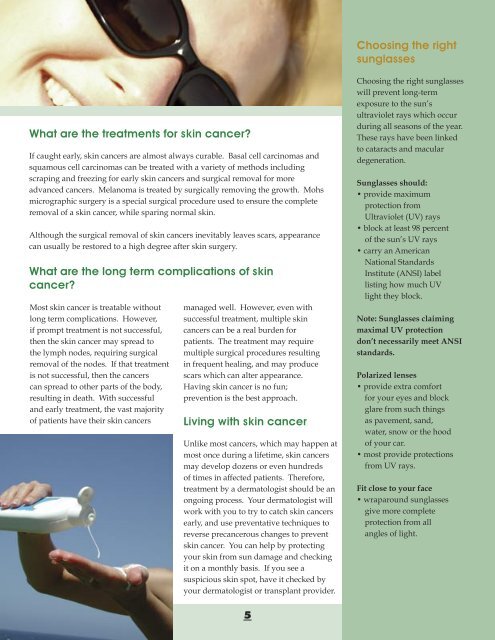Skin Cancer Risks in Transplant Recipients: Know the Facts
Skin Cancer Risks in Transplant Recipients: Know the Facts
Skin Cancer Risks in Transplant Recipients: Know the Facts
Create successful ePaper yourself
Turn your PDF publications into a flip-book with our unique Google optimized e-Paper software.
Choos<strong>in</strong>g <strong>the</strong> right<br />
sunglasses<br />
What are <strong>the</strong> treatments for sk<strong>in</strong> cancer?<br />
If caught early, sk<strong>in</strong> cancers are almost always curable. Basal cell carc<strong>in</strong>omas and<br />
squamous cell carc<strong>in</strong>omas can be treated with a variety of methods <strong>in</strong>clud<strong>in</strong>g<br />
scrap<strong>in</strong>g and freez<strong>in</strong>g for early sk<strong>in</strong> cancers and surgical removal for more<br />
advanced cancers. Melanoma is treated by surgically remov<strong>in</strong>g <strong>the</strong> growth. Mohs<br />
micrographic surgery is a special surgical procedure used to ensure <strong>the</strong> complete<br />
removal of a sk<strong>in</strong> cancer, while spar<strong>in</strong>g normal sk<strong>in</strong>.<br />
Although <strong>the</strong> surgical removal of sk<strong>in</strong> cancers <strong>in</strong>evitably leaves scars, appearance<br />
can usually be restored to a high degree after sk<strong>in</strong> surgery.<br />
What are <strong>the</strong> long term complications of sk<strong>in</strong><br />
cancer?<br />
Most sk<strong>in</strong> cancer is treatable without<br />
long term complications. However,<br />
if prompt treatment is not successful,<br />
<strong>the</strong>n <strong>the</strong> sk<strong>in</strong> cancer may spread to<br />
<strong>the</strong> lymph nodes, requir<strong>in</strong>g surgical<br />
removal of <strong>the</strong> nodes. If that treatment<br />
is not successful, <strong>the</strong>n <strong>the</strong> cancers<br />
can spread to o<strong>the</strong>r parts of <strong>the</strong> body,<br />
result<strong>in</strong>g <strong>in</strong> death. With successful<br />
and early treatment, <strong>the</strong> vast majority<br />
of patients have <strong>the</strong>ir sk<strong>in</strong> cancers<br />
managed well. However, even with<br />
successful treatment, multiple sk<strong>in</strong><br />
cancers can be a real burden for<br />
patients. The treatment may require<br />
multiple surgical procedures result<strong>in</strong>g<br />
<strong>in</strong> frequent heal<strong>in</strong>g, and may produce<br />
scars which can alter appearance.<br />
Hav<strong>in</strong>g sk<strong>in</strong> cancer is no fun;<br />
prevention is <strong>the</strong> best approach.<br />
Liv<strong>in</strong>g with sk<strong>in</strong> cancer<br />
Unlike most cancers, which may happen at<br />
most once dur<strong>in</strong>g a lifetime, sk<strong>in</strong> cancers<br />
may develop dozens or even hundreds<br />
of times <strong>in</strong> affected patients. Therefore,<br />
treatment by a dermatologist should be an<br />
ongo<strong>in</strong>g process. Your dermatologist will<br />
work with you to try to catch sk<strong>in</strong> cancers<br />
early, and use preventative techniques to<br />
reverse precancerous changes to prevent<br />
sk<strong>in</strong> cancer. You can help by protect<strong>in</strong>g<br />
your sk<strong>in</strong> from sun damage and check<strong>in</strong>g<br />
it on a monthly basis. If you see a<br />
suspicious sk<strong>in</strong> spot, have it checked by<br />
your dermatologist or transplant provider.<br />
Choos<strong>in</strong>g <strong>the</strong> right sunglasses<br />
will prevent long-term<br />
exposure to <strong>the</strong> sun’s<br />
ultraviolet rays which occur<br />
dur<strong>in</strong>g all seasons of <strong>the</strong> year.<br />
These rays have been l<strong>in</strong>ked<br />
to cataracts and macular<br />
degeneration.<br />
Sunglasses should:<br />
• provide maximum<br />
protection from<br />
Ultraviolet (UV) rays<br />
• block at least 98 percent<br />
of <strong>the</strong> sun’s UV rays<br />
• carry an American<br />
National Standards<br />
Institute (ANSI) label<br />
list<strong>in</strong>g how much UV<br />
light <strong>the</strong>y block.<br />
Note: Sunglasses claim<strong>in</strong>g<br />
maximal UV protection<br />
don’t necessarily meet ANSI<br />
standards.<br />
Polarized lenses<br />
• provide extra comfort<br />
for your eyes and block<br />
glare from such th<strong>in</strong>gs<br />
as pavement, sand,<br />
water, snow or <strong>the</strong> hood<br />
of your car.<br />
• most provide protections<br />
from UV rays.<br />
Fit close to your face<br />
• wraparound sunglasses<br />
give more complete<br />
protection from all<br />
angles of light.<br />
5

















